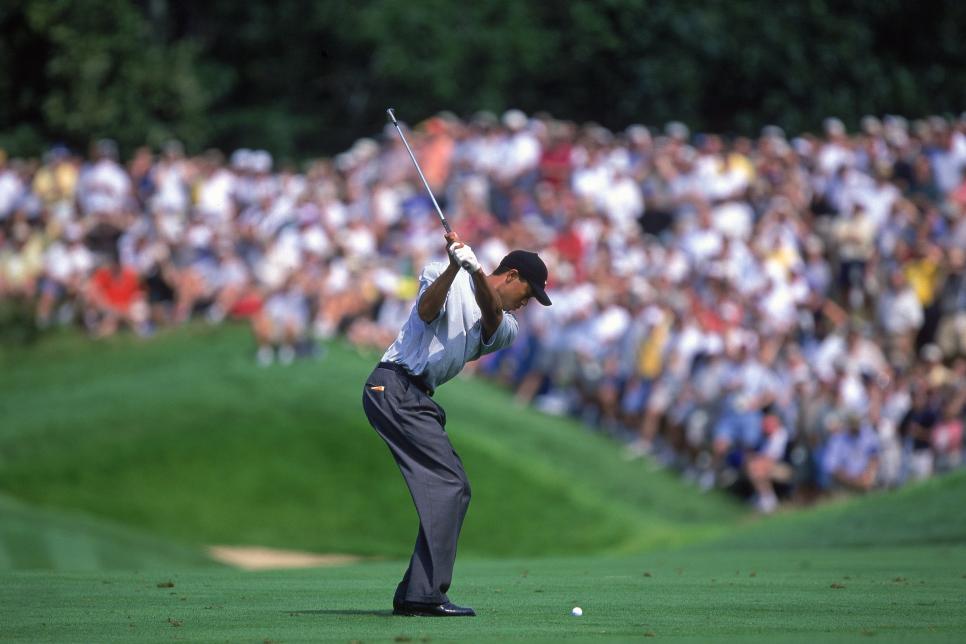This was Tiger’s shot-shaping key from his most dominant year on tour – Australian Golf Digest

- by Admin
- April 26, 2024

The 2000 PGA Tour season was Tiger Woods’ best and one of the greatest seasons any tour player has ever had. That year he won three consecutive major championships—the U.S. Open, Open Championship and PGA Championship—by a combined 24 shots. He had nine total wins in 2000, and he was named the PGA Tour Player of the Year.
Although Woods lapped the tour that year in just about every area of the game, he was best known for his brilliant iron play, knocking down flagsticks and leaving a lot of easy birdie looks. For the 2000 season, he ranked No. 1 on tour in greens hit in regulation (75.15 percent). That’s more than three out of every four greens!
To give you an idea of just how good he was that year, there hasn’t been a player on the PGA Tour who has hit greens at that high a clip in the last decade.
Tiger’s contact with the irons was so pure in the early 2000s that the tiny wear pattern on his clubfaces is still talked about to this day.
$1 million clubs? Tiger irons used during historic season expected to fetch record price at auction
This got me thinking: If Tiger’s best year was 2000, wouldn’t that be the best time to get some iron-play tips from him?
Unfortunately, I can’t go back in time to ask him, but I do have the Golf Digest Archives at my disposal. So, I dove into the old issues, unearthed some great Tiger instruction and asked my colleagues to help me pick Tiger’s best iron tip from his best year. Now you can dial in your iron play with these nuggets of wisdom from the February 2000 issue.
At that time, Tiger said his natural ball flight was a draw, but he often preferred to play a fade because it gave him more control.
“I can’t always depend on the draw to be gentle enough and stop where intended,” Tiger said. “I need a reliable shot that will fly the right distance and land softly. For me, it’s the high fade.”
HOW TO HIT TIGER’S KILLER FADE
David Cannon
Tiger said in the article that he uses his stance to pre-set a high, soft-landing fade.
“Play the ball slightly forward in your stance . . . align your feet and body to the left of your target (for right-handed golfers) . . . take the club back and through on the line of your feet.”
Sounds pretty simple, and here’s the kicker:
“Don’t let your arms release as much as normal through impact,” Tiger said, “and limit the rotation of your wrists.”
Tiger went on to say that to hit the fade, allow your right arm to extend down the target line through impact, not to the left, as it does for a draw. And don’t cut off your finish—you’ll just hit a weak slice.
So there you have it: Tiger’s secret to playing those laser fades that helped him hit greens at a phenomenal rate and dominate the tour in 2000. Get out there and give it a try.
Check out the Golf Digest Archives for more instruction from golf’s greatest players and teachers.
This article was originally published on golfdigest.com
The Latest News
-
December 23, 2024‘Got some good bants’: Hilarious stump mic warning as Konstas plots secret Bumrah counter
-
December 23, 2024Former AFL player Aaron Shattock fighting for life after excavator accident
-
December 23, 2024Naomi Osaka questions Nike in statement regarding Australian Open outfits
-
December 23, 2024Aussie NFL Wrap-up: How did Jordan Mailata, Tory Taylor, and more perform in Week 16? | Sporting News Australia
-
December 23, 2024Australia Post customer lashes out over ‘scam’ hurting small businesses: ‘So frustrating’





